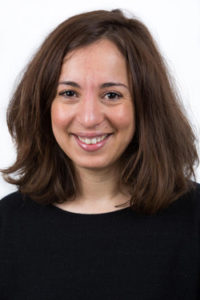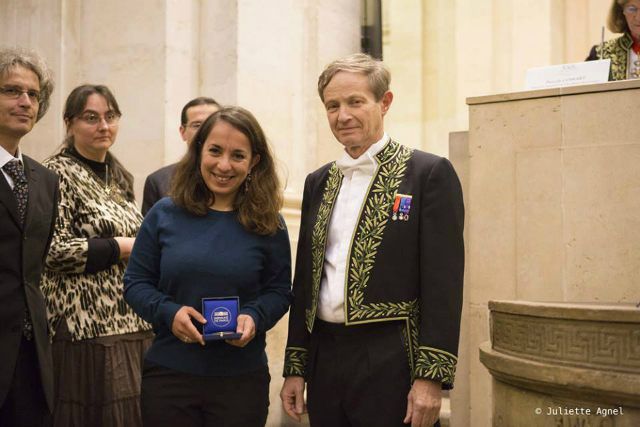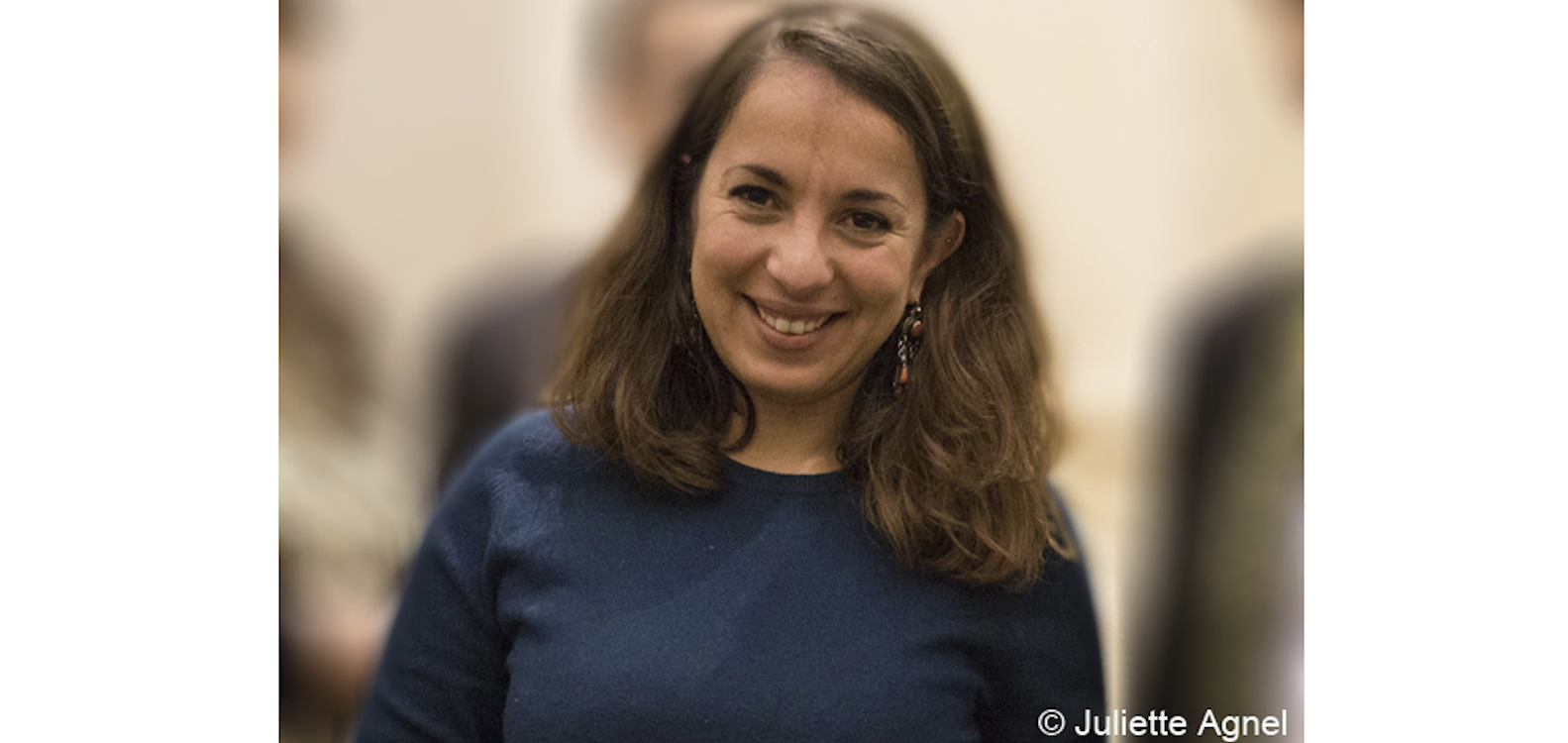Interview | Dr Yasmine Amhis laureate of the Grand Prix Jacques Herbrand in Physics
Inspire Magazine speaks to Dr Yasmine Amhis, researcher at the Linear Accelerator Laboratory (LAL) in Orsay, a joint unit of the National Institute of Nuclear Physics and Particle Physics (IN2P3) and the Centre national de la recherche scientifique (CNRS) and the University of Paris-Sud. In November 2016, Dr Amhis received the Grand Prix Jacques Herbrand in Physics awarded by the French Academy of Science for her contribution to the LHCb experiment at CERN with respect to the physics of heavy quarks. This area is promising for the study of deviations from the standard model and also for understanding the mechanism responsible for the violation of matter-antimatter symmetry.
Inspire Magazine: Thank you for speaking to Inspire Magazine, and many congratulations for winning the prestigious Jacques Herbrand Prize. How do you feel about this achievement?
Yasmine Amhis: Thank your for this interview. I feel very proud. Especially for my family who was always supportive of my work.
IM: Before we get into your work, coud you tell us a little about your background and your journey that led you to where you are now?

Dr Yasmin Amhis
YA: I was born and raised in Algiers, in high school I was in “Sciences Exact”. I arrived in France in 1999 to start medicine. For various reasons medicine didn’t quite work out for me, so I started to study fundamental physics which I loved very much. I did the equivalent of bachelor and master. I did a PhD in particle physics between 2006 and 2009. After that I was a post-doc in EPFL. I was partly based at CERN. In 2012 I got a job in CNRS where I am now a “chargé de recherche”.
IM: Could you tell us about your current work, what are the big questions that your trying to answer at the moment, and how are you going about answering them?
YA: I am a member of the LHCb experiment. Its one of the four experiments on the LHC ring at CERN. The main goal of our experiment is to study the difference between matter and anti-matter but also to look for signs of what we call physics beyond the Standard Model. The Standard Model is today somehow the best description that we have of the fundamentals laws of nature. What is interesting is that while this model is very powerful and predictive it fails to explain some aspects for nature such as dark matter. Therefore physicists know that there must exist a more complete theory of nature and this is what we are looking for. Right now, I am working on a so called “Lepton Universality” test. The idea is very simple. In the Standard model you expect the behaviour of electrons and muons (which are both leptons) to be the same in the decay of certain particles. So we are making measurements to see if this verified in our data or not. It’s what we call indirect searches. Because we don’t look directly for new particles, but we look for deviations of very well predicted observables.
IM: Your lab is a leading discoverer of particles, could you give us a simplified overview what your discovery means, and how future experiments can help us learn more? For instance, should we expect more of these kinds of discoveries in the future?
YA: My institute indeed participated in the discovery of many particles since it was created in the fifties. I think it’s important to emphasise the collaborative aspect of these discoveries in particular in the collider physics. The facilities and detector which were and will be built are gigantic and they need the association of many institutes in many countries. Right now we are in a phase of data taking at the LHC, it’s hard to predict if we are going to find “new” things or not, but we are all certainly hoping to find something interesting in the data.

Yasmine Amhis receiving the Jacques Herbrand (physique) prize
IM: The research model of modern physics, unlike other fields, seems to have evolved to be dominated by very few and very large collaborations, such as CERN and LHC. What are you thoughts about how useful this model is?
YA: Being in a member of a rather big collaboration, about a thousand people, has its pros and cons. What makes it very interesting is that as a physicist you get to interact with many people from various places in the world. If you are smart about it, you can increase your chances of learning new things, this can be experimental techniques or tricks even new or simply different ways of thinking and approaching problems. The counter part is that it can be overwhelming, the size of the experiment is so big that it’s very hard maybe impossible to understand in great details every aspect of the detector for example.
IM: Given this research model, how would you say young scientists can climb up the field, for instance in terms of publication management and so on? What would be your advise for them on how to be successful within this model?
YA: The rule in the LHCb Collaboration is that all the members sign all the papers and their names appear in alphabetical order. The reason for this is that as a member of the Collaboration you can participate to many aspects of the experiment for example design of the experiment, construction, commissioning, data taking, data analysis etc. What happens when people apply for jobs is that they highlight the papers where you had a significant contribution.
IM: What’s your take on the current status of your field of research in Algeria, and what are your perspectives on how this field could be promoted and developed back home?
YA: I will concentrate on particle physics, what I can tell you is that the beauty of data analysis, which is what I mainly do, is that it can be done from any where. “All” you need a is good internet connection. Algeria is currently in the CERN organisation as a “Non-Member States with co-operation agreements”. Could we imagine having a bigger contribution from Algeria? This would be certainly be great for Algerian physicists, engineers and technicians. But I am afraid that I don’t have enough information to be able to judge if this is a real possibility or not.
IM: Many thanks again for taking the time to speak to Inspire Magazine and all the best with your future endeavours
YA: Thank you!
أجرت مجلة “INSPIRE MAGAZINE ” حوارا مع الباحثة الجزائرية ياسمين امحيص التي تعمل في مخبر (LAL) في اورساي ” ORSAY” وهو فرع مشترك للمعهد الوطني للفيزياء النووية و فيزياء الجسيمات (IN2P3 ) لمركز الوطني للأبحاث العلمية النووية (CNRS) وجامعة باريس جنوب “PARIS SUD”
وحازت الباحثة الجزائرية على الجائزة الكبرى ” JACK HERBAND”حيث تم تكريمها من قبل الأكاديمية الفرنسية للعلوم في نوفمبر 2016 نظرا لمساهمتها في تجربة ( LARGE HARDON COLLIDER BEAUTY)” مصادم هاردون الكبيير ” التي أجريت في مركز الأبحاث النووية “CERN”اعتمادا على فيزياء الكوركات الثقيلة ويهتم هدا المجال من البحث بدراسة حالات الخروج عن النموذج القياسي وفهم الآليات المسؤولة عن انتهاك الجسيمات و
نسخها المضادة بطرق مختلفة.
المجلة: نشكركم على منحنا فرصة إجراء هذه المقابلة الصحفية لمجلة “INSPIRE MAGAZINE ” ونقدم تهانينا الحارة بمناسبة حصولك على الجائزة الكبرى “JACK HERBAND” .
حدّيثينا عن شعورك حيال هذا الانجاز؟
ياسمين أمحيص: أود في البداية أن أشكركم على إجرائكم لي لهذه المقابلة .
أمّا بعد اشعر كثيرا بالفخر خاصة حيال أسرتي التي لم تبخل يوما بدعمي وساندتني طوال مشوار ي المهني.
المجلة: قبل الخوض في الحديث عن عملك ,حديثينا قليلا عن مسارك الدراسي و رحلتك التي أوصلتك لتحقيق هذا الانجاز.
ياسمين: ولدت وترعرعت في الجزائر العاصمة أين درست بالثانوية تخصص العلوم الدقيقة ثم غادرت البلاد متجهة نحو فرنسا سنة1999 لدراسة الطب ولكن لأسباب عديدة لم ياستهويني هذا الميدان كثيرا فقررت إن أتوجه لدراسة الفيزياء الأساسية فتحصلت على شهادة ليسانس ثم ماستر وبعدها نلت شهادة الدكتوراه سنة 2006-2009 في فيزياء الجسيمات و بعدها أصبحت اعمل “مكلفة بالبحث” عام 2012م في معهد الأبحاث العلمية النووية CNRS .
المجلة: هلا أخبرتنا المزيد عن عملك الحالي و ما هي أهم المسائل التي تواجهك وكيف تتعاملين في حلها؟
ياسمين: اعمل حاليا عضوا في تجربة LHCB ” لمصادم هاردون الكبير(LHC) حيث يعد من بين التجارب الأربعة التي أجريت على حلقة مصادم هردون الكبير(LHC ) في مركز التجارب العلمية النووية (CERN) و تهدف هده التجربة لدراسة الاختلافات بين المادة و المادة المضادة بالإضافة إلى الكشف عن العلامات التي يطلق عليها في علم الفيزياء ما يعرف ب : ما وراء
النموذج القياسي.
ويعرّف النموذج القياسي بالوصف الدقيق للقوانين الأساسية للطبيعة و رغم قوة تنبؤ هذا النموذج إلا انه يفشل أحيانا في شرح بعض الظواهر الطبيعية مثل:المادة الداكنة. مما دفع بعض الفيزيائيين لضرورة إيجاد نظرية كاملة حول الطبيعة وهذا ما نعمل عليه حاليا.
إذ نجري الآن ما يسمى : باختبار”كونية ليبثون” ” LEPTON UNIVERSALITY ” أي ضبط و مراقبة المعطيات التي لا يمكن الكشف عليها في النموذج القياسي العادي حيث تكون كل من أن الالكترونات و الميونات ( ليبثون ) هي نفسها أثناء اضمحلال بعض الجسيمات.
و هذا ما نطلق عليه بالأبحاث غير المباشرة لاننا لا نبحث مباشرة عن الجسيمات جديدة بل نبحث عن الانتهاك الذي يمكن حدوثه و يمكن رؤيته.
المجلة: من المعروف عن مخبركم أنه رائدا في اكتشاف الجسيمات,هلا تفضلت بنظرة شاملة حول موضوع البحث و مدى مساهمة هذه التجارب في التعلم؟و هل بوسعنا أن نتطلع للمزيد من هدا النوع من الاكتشافات في المستقبل؟
ياسمين: لقد ساهم مخبرنا بالفعل منذ تأسيسه قي الخمسينات اكتشاف المزيد من الجسيمات لكن أرى انه من الضروري تفعيل الجانب التعاوني لهذا النوع من الاكتشافات خاصة في ميدان الفيزياء المصادم ( collider physics) فبالرغم من وجود و وفرة كل التسهيلات و الأجهزة الكاشفة الضخمة إلا أن هذا النوع من البحوث بحاجة ماسة إلى مشاركة العديد من المعاهد عبر مختلف أرجاء العالم.
أما الآن فنحن بصدد تدوين البيانات في مخبرLHC, إذ من الصعب جدا التنبؤ بوجود أشياء من عدمها, أملين طبعا إيجاد شيء مفيد في البيانات.
المجلة:لقد تطور نموذج بحث الفيزياء المعاصرة خلافا للمجلات الأخرى وسيطرت عليه أقلية محدودة من المؤسسات التعاونية دو الصيت الواسع على غرارCERN وLHC .
فيا ترى ما مدى فعالية هدا النموذج؟
ياسمين: أن تكون عضوا في مثل هده المؤسسات التعاونية الكبرى لها طابعها الايجابي و السلبي حتما , فكونك فيزيائي سيتيح لك حتما عديد الفرص لتتواصل وتتفاعل مع أشخاص من مختلف أرجاء العالم مما يزيد من فرص تعلمك لأشياء جديدة.
في المقابل يمكن أن يكون هذا الشئ مربكا في بعض الأحيان فكلما كان حجم التجربة كبيرا كلما صعب وحتى استحال فهم التفاصيل الدقيقة لكل جانب من جوانب جهاز الكشف مثلا.
المجلة: لو تم تطبيق هذا النموذج فعلا ما النصيحة التي يمكن تقديمها للشباب للمضي قدما في هدا المجال من البحث او غيرها من المجالات الأخرى؟
ياسمين :إن من قوانين التجربة المشتركة LHCB هو وجوب توقيع كل الأعضاء على كل الأوراق فتظهر أسماء الأعضاء الذين قدموا مساهمة قوية في ترتيب أبجدي وهدا للسماح لهم بالمشاركة في العديد من جوانب التجربة كتصميم التجربة و عملية البناء والتكليف وتدوين البيانات و تحليلها…وغيرها من الجوانب الأخرى.
المجلة :كيف يمكن وصف الحالة الراهنة لهذا المجال في الجزائر و ما هي تطلعاتك للنهوض و الرقي بهذا النوع من الأبحاث ف بلادك؟
ياسمين: أركز على فيزياء الجسيمات باعتبارها مجال تخصصي أقول إن كل ما يتطلبه هذا الميدان من البحث هو التدفق العالي للانترنت. فتحليل البيانات و المعطيات التي كنت شخصيا اشرف عليها يمكن لأي احد من أي مكان في العالم القيام بها شرط وجود تدفق عالي للانترنت فقط.
و الجزائر حاليا هي عضوا في منظمة CERN و لكن ليست عضوا في اتفاقية التعاون, إذن فهل يمكن تصور مساهمة كبرى من قبل الجزائر!!!
كان من الممكن أن يكون ذلك شيئا عظيما بالنسبة للفيزيائيين و المهندسين والتقنيين ولكن لا يمكنني أن اصدر حكما بشان إمكانية الجزائر من عدمه و هذا لقلة معرفتي بخبايا هذا المجال في الجزائر.
المجـلة: شـكرا جـزيــلا مـرة أخـرى لمنحي فـرصة الحديث إليك مع تمنيـاتي وتمنيات كـل طاقـم المجـلة بـالنجاح في مساعيـك المستقبـليـة.
(ترجمة أحلام بيرا)

About the Author